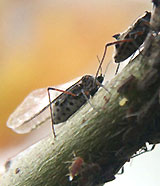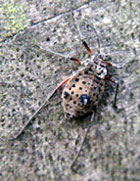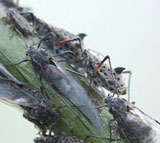Large willow aphid

Fig.1 Large willow aphid (Tuberolachnus salignus) winged female
Most of us know aphids - greenfly and blackfly , as garden pests. The insect species Tuberolachnus salignus (large willow aphid) is one of the largest aphids in Britain but even so, little is known about its biology, lifecycle and distribution. Every year, in about February, it does a disappearing act and for about five months its whereabouts remain a mystery.
No males have been recorded in this species and this may be because no males actually exist. The females are able to reproduce without males and give birth to live young that are genetically identical (clones). During certain seasons some aphid species can produce hundreds of young in a couple of weeks but more usually one aphid produces 5-10 young a day, for 10-20 days.

Fig.2 Large willow aphid (Tuberolachnus salignus) wingless female
Many aphid species are not able to over-winter unless the weather is very mild. It is clear that T. salignus has no trouble over-wintering as adults and young, in contrast to other species that need to over-winter as eggs for survival. Eggs in these species are formed through sexual reproduction something that T. salignus seems not to have retained.
The females that have been recorded and collected have two forms: winged (Fig.1) and wingless (Fig.2). External temperatures can determine whether wings develop or not.
The aphid has been recorded and collected from August through to very early March but then none have been seen for the following 5 months. Where do they go? No doubt some are eaten by birds or other predators but how many survive?
It is in February that populations tend to decrease and within weeks they have disappeared. Several years of observation have shown that this aphid seems to be very active during cold frosts and heavy snow around January and February. They spend time leaving their host plant, walking along the ground, over rocks and along the handrails of foot-bridges. This aphid is certainly one of the fastest that is commonly seen.

Fig.3 Large willow aphid (Tuberolachnus salignus)
The very large dark-brown aphid is covered with fine, silky grey hair. Adults are about 5mm long (from head to end of the abdomen) and the abdomen has a large conical tubercle on its back and from the side is very distinguishable (Fig.3). The young do not have this tubercle.
The aphid is known to live on willow and sallow trees and can form dense colonies on the trunk and branches, not on the leaves. If disturbed the aphids kick out their long back legs and wave them about.
This large aphid is very distinctive and there is nothing else like it, so if it doesn't have a large thorn-like process on its back then it is not T. salignus.
Book list
Blackman, R. 1974. Aphids. Ginn and Company Ltd. 1-175.
Any good tree guide
Specialist reading
Blackman, R. & Eastop, V. 1994 Aphids on the Worlds Trees. An identification and Information Guide. CAB International. 1-987.
Toolbox

The Museum's smallest members of staff are our flesh-eating beetles, Dermestes maculates, who strip carcasses to the bone.